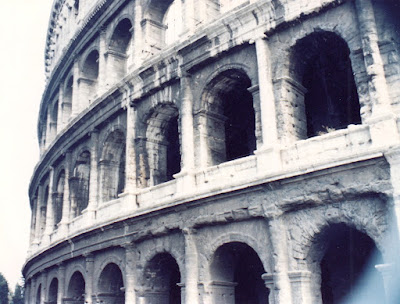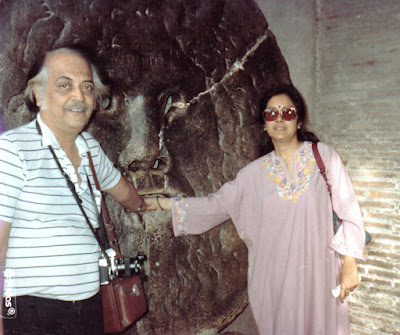 |
| The iconic Colloseum |
We reached Rome from Florence in less than two hours. Having read so
much and having seen numerous Hollywood movies featuring Rome produced during
what is termed as the Golden Era of Hollywood the anticipation was great. Who
can forget the film Roman Holiday with Audrey Hepburn and that handsome, huge
hulk of a man, Gregory Peck? Then that musical featuring Frank Sinatra singing
in his deep voice “Three coins in the
fountain” shot at Trevis Fountain of Rome;
as also the film La Dolce Vita featuring Anita Ekberg and Marcello Mastroianni
with his histrionics. That we were going to be there soon excited us no end.
 |
| Trevis Fountain |
Booked again in a pension that
was located in a more than hundred-year old heritage building which, if I
recall, was around three storeys tall but
retrofitted with a communication
system from the main door on the ground floor to the second floor where the
lady of the house was mostly available. She would operate a lever to allow
access to the building. It also had a retrofitted small lift which could at
best take three people with their bags.
Regardless of its small dimensions it was quite a relief as otherwise
one would have had to climb those numerous steps to get from one tall floor to
another. From outside, the building gave a gloomy look painted in a drab grey
but inside it was bright and very well appointed. This
only shows how heritage
structures are taken care of by people and the government in Italy. This is
what seems to be true in most European cities where heritage is conserved and
it sells.
 |
| Spanish Steps |
 |
| Another view of Trevis Fountain |
I do not think there would be any point in writing about Rome much as
most of us are familiar with it – its history, its culture, its beautiful
architecture and that it also has the Vatican within its confines, the only
instance in which a state is located within the municipality of a city. It
probably was the only city after which an empire and a civilization were named.
That was in the hoary past, before and after Christ which, in fact, is
described as the Roman Imperial
Period. Centuries later, however, Rome added
aesthetics to its military prowess and spiritual attainments. It became the
centre of that socio-cultural movement that is called Renaissance, a movement
that started in Italy in the Late Medieval period and spread to the rest of
Europe. Rome became one of the centres of Renaissance as most popes “pursued a
coherent policy along four hundred years an architectonic and urbanistic
programme to make the city the world’s artistic and cultural centre”. Famous artists,
painters, sculptors and architects made Rome the centre of their activity,
creating masterpieces throughout the city. That is
precisely why the city is so attractive – full as it is of architectural and sculptural
wealth. On
every street one would find a marvellous structure, a slim aesthetically
designed column or even an obelisk and in every piazza a running fountain
surrounded by a host of sculptured religious or historical figures.
 |
| A Roman street with a column in a piazza ahead |
 |
| My wife somewhere near the ColloseumAdd caption |
Inevitably our Rome visit
commenced with a trip to the Colloseum. Situated, more or less, at the centre
of the city the first impression of it strikes one with awe followed by
incomprehension and incredulity.
That such a huge multi-tiered structure of
large stone pieces could be made more than 2000 years ago was simply
unbelievable. No wonder it is still treated as the largest amphitheatre ever
built. It could seat at least 50000 spectators at a time. Seating arrangement
was in tiers and strictly in accordance with the social stratification that was
prevalent then in the Roman society. Huge
numbers of stairways were provided
for jostle-free entrances and exits. Underneath, there was a network of tunnels
cages and rooms for temporarily housing wild beasts and the gladiators who were
to fight them generally to death. Standing there one could only imagine the
gory sight and even hear the excited roar of the crowd followed by wild
clapping as a big,
burly man fell to a beast or to a bigger, more muscular
beastlike man.
 |
| Ruins of ancient Rome |
 |
| St. Peter's Basilica |
 |
| A colonnaded section of St. Peter's Square |
We wandered around the city generally
in awe. In all directions there seemingly was a sumptuous visual feast of art
on stone – in architecture or sculpture. As was planned we took the Fontana di
Trevis first where we remembered Frank Sinatra chucking coins into the pool
singing “Three coins in
the Fountain”. It is an amazing place – a fountain with
a huge backdrop of sculptures framed in stone with columns on their sides. It
is perhaps the largest Baroque fountain in the city and one of the most famous
in the world. Built by architects who won a competition for its design, it took
around 30 years to complete in 1762. Its massive proportions are incredible
-
around 90 ft. tall and 150 ft. wide. The backdrop is a palace that is now a
museum and the sculptors went to work on it creating figures flanked by
Corinthian free-standing columns and down below a jumble of figures seemingly
playing around in water. The central figure represents Oceanus. The water,
apparently, comes from a stream a few kilometres away from Rome to which, the
legend has it, thirsty Roman soldiers were led by a virgin as far back as in 19
BC. We literally tore ourselves away
from the captivating ambiance after
chucking a few coins in the fountain.
 |
| a la Roman Holiday |
 |
| Piazza Venezia and the Victor Emanuel II Memorial |
 |
| In the St. Peter's Square |
Piazza di Spagna again has a
fountain and from here the Spanish Steps, a broad stairway, climbs a hill to a
church which, I later learnt, was the church of Trinita die Monti. The stairway
up the hill was constructed again on the basis of a competition and the
architect considered best was allotted the
work. In Italy during the
Renaissance almost all aesthetic works were assigned to an artist on the basis
of merit. Spanish Steps are also credited to be one of the widest stairways in
the world. The church on the hill above is French and the area around it is
controlled by French authorities. Just below it stands a tall an obelisk
brought perhaps from Egypt.
 |
| In front of ancient Roman ruins |
Not everything that we saw can
perhaps be described but one more piazza that was impressive was Piazza
Venezia. It takes the name
from Palazzo Venezia which is in the neighbourhood
and, at one time, used to be the embassy of the Republic of Venice in Rome. It
is practically the centre of Rome and criss-crossed by several arterial roads.
The piazza is dominated by the very impressive monument built in the 19th
Century to honour the first King of Italy, Victor Emanuel II. It features
stairways, Corinthian columns, fountains and an equestrian statue of King
Victor Emanuel.
 |
| A bridge on the River Tiber with statues on its balustrade |
On the last day of our stay we
went to Vatican City. Vatican is a walled enclave inside Rome with an area of
100-odd acres and a
population of less than 1000. That makes it the smallest
state in the world area-wise and population-wise and yet it confines within
itself an unparalleled cultural wealth. Not only does it have, the St. Peter’s
Basilica and the Sistine Chapel it also has a few museums where some of the world’s
most famous paintings and sculptures are in display. Alas, all that was not for
us as we had neither time nor the money to visit so many sites that included
galleries, museums and places of interest. My
wife and her sister, did,
however, go and visit Sistine Chapel. I satisfied myself by visiting St.
Peter’s Basilica and hanging around St. Peter’s Square.
 |
| Another massive Roman piazza with an obelisk at the centre |
 |
| Sitting on the balustrade of Trevis Fountain |
A renowned Italian Renaissance
church, St. Peter’s Basilica was designed, among others, by Michelangelo and
Bernini. The Basilica’s dome is known as Michelangelo’s dome. It is one of the
biggest churches in the world that holds an unique position in the Christian
world as the greatest of all churches in
Christendom and the holiest of the
Catholic shrines. It was constructed to replace an earlier one and it took more
than a hundred years to build during the sixteenth an seventeenth centuries.
The shrine takes the name after St. Peter who was one of an apostles of Christ
and was also the first pope. He was crucified somewhere near the obelisk within
the St. Peter’s Sqaure and is interred directly below the altar in the church.
 |
| Spiral stareway in the Basilica |
 |
| Another view of Colloseum |



No comments:
Post a Comment